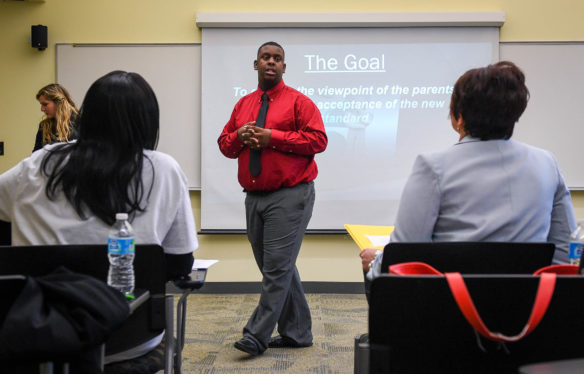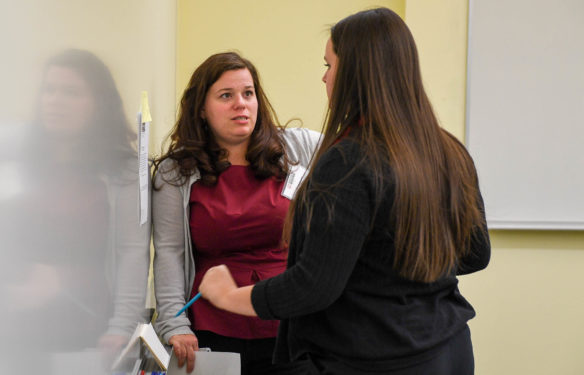
Michael Biggers, a junior from Seneca High School (Jefferson County), and his partner, junior Kali Riggs, present to judges at the Educators Rising conference about ethical dilemmas teachers might face. For the competition, students were asked to explain how they would handle parents disagreeing with new teaching standards at schools. Kentucky recently formed a state chapter of Educators Rising in hopes of encouraging more students to pursue careers in education.
Photo by Bobby Ellis, March 11, 2017
By Brenna R. Kelly
Brenna.kelly@education.ky.gov
Filling teaching positions in Kentucky can be hard.
“We have a teacher pipeline issue in Kentucky,” said Kelly Stidham, the Kentucky Department of Education’s (KDE) teacher effectiveness coach. “We just don’t have enough teachers and the teaching population that we have is not proportional to our student population, racially or geographically. We also have critical shortage areas by discipline.”
So KDE is launching two new ways to help schools and districts get the teachers they need, while at the same time helping high school students who aspire to become teachers reach their dream.
A new career and technical education career pathway in education will start in the 2017-18 school year. The pathway’s students also will have a new statewide co-curricular student organization called Educators Rising to support them.
“We are excited,” said Stidham, who served on the task force to create the new pathway and is the state coordinator for the student group. “Educators Rising and the new pathway are two different, but very complementary, projects.”
Superintendents across the state have told the Education Professional Standards Board (EPSB) that they have a hard time filling teacher vacancies, EPSB Executive Director Jimmy Adams said in a report last year. But Adams believes the state doesn’t have teacher shortage problem, it has a teacher distribution problem.
“The problem is that certified teachers are not choosing to seek positions where the job vacancies exist,” he wrote. “Additionally, we produce more elementary teachers than we have need.”
The problem is especially acute in rural areas of eastern and western Kentucky, said Wayne Stevens, a KDE effectiveness coach who also served on the task force.
“What we hear so often from our rural districts is that they have an abundance of people who are coming back to teach elementary, maybe teach English or social studies, but they are having a harder time finding teachers who want to come back and teach math, science or other areas,” he said.
For the 2016-17 school year, Kentucky had critical teacher shortages in 13 different disciplines and content areas, including special education, math and science, according to the U.S. Department of Education.
When districts do fill their positions, many teachers stay for only a year or two before finding a job at a larger district or a district near their hometown, Stevens said.
In Kentucky, many teachers end up teaching close to home. Just over 38 percent of teachers were hired in the district where they student taught and about 27 percent teach in the district where they went to school, according to EPSB.
“This pathway is really intended for districts to help grow their own teachers so that five or six years down the road, they are not in this continuous cycle of always trying to find a replacement teacher,” Stevens said.
The new Teaching and Learning pathway is designed to allow more schools to offer an education pathway, appeal to more students and allow students to get classroom experience sooner. The pathway will be offered in addition to the Fundamentals of Teaching, the current education pathway which is under Family and Consumer Sciences, Stevens said.
Only about 20 schools across the state offer the Fundamentals pathway because the courses have to be taught by a Family and Consumer Sciences teacher and those teachers have many other classes, he said. Courses in the new Teaching and Learning Pathway can be taught by any educator who has been teaching for five years and has a Rank II certification, usually a master’s degree.
KDE staff also felt students should be able to get more clinical experiences in teaching, so the new pathway’s courses are all clinical-based, he said.
The pathway, which was which was created by KDE’s Office of Teaching and Learning and the Office of Career and Technical Education, includes four courses. All students in the pathway take the first three courses, which focus on the general theory and practice of learning and teaching, the basic principles of educational psychology, the art of teaching, planning and administration, school safety and health issues, and the social foundations of education.
For the fourth course, students can choose from Collaborative Clinical Experience, Principles of Career and Technical Education or an AP or dual credit course in their intended discipline. The idea is that by allowing AP or dual credit, the pathway will appeal to more students are who interested in math and science.
“We heard often that students who were interested in math and science, which are areas where we need more teachers, wanted to take AP or dual credit courses, so that made it hard for them to complete a career pathway,” Stevens said.
The Collaborative Clinical Experience will involve student teaching with an educator in the district.
“If somebody wants to be an elementary special education teacher, then the elementary special ed teacher in the district could supervise that fourth course,” Stevens said.
Thirty eight high schools signed up to offer the new pathway in its first year. Although the deadline to offer the pathway for the 2017-18 school year has passed, more schools will be able to offer the pathway in 2018-19.
While the goal is to encourage students to become teachers, students who take the pathway but later change their mind won’t have wasted their time, Stidham said.
“By design it includes a lot of transferable skills, metacognitive skills that will be beneficial to students no matter what profession they choose,” she said.
For the students who are serious about pursuing a career in education, the Educators Rising student group will give them additional experience and support, she said.
More than 50 schools across the state already have Educators Rising chapters, Stidham said, but Kentucky did not have a state chapter. The new chapter allows students to network with each other and provides access to resources such as Atlas, a collection of videos from National Board certified teachers.
“It’s an opportunity for our students to be recognized as leaders and have a student organization where they can compete to go to a national conference,” Stidham said.

Kelly Stidham, an effectiveness coach with the Kentucky Department of Education, speaks with Alysa Forden, a junior at Atherton High School (Jefferson County), before the start of her impromptu speaking challenge at the Educators Rising conference at Kentucky State University in Frankfort. The organization supports high school students who want to become teachers. Photo by Bobby Ellis, March 11, 2017
Kentucky’s first Educator Rising conference was held March 11 at Kentucky State University. More than 50 students competed in 19 events, including impromptu lesson planning, public speaking, job interviews and children’s literature.
The students also got to meet representatives from Kentucky’s education colleges, Kentucky Education Association, the Hope Street Group and other education advocates.
“We have a lot of support from across the teaching community. That’s one of the things we were most excited about for the conference, was to connect our rising educators and really make a place for them at the table,” Stidham said. “It allows them to become part of that community and to see themselves as an active part the profession right away.”
Both the pathway and student organization have the potential to create teachers who are more prepared when they step into a classroom after college, she said.
“Sixty percent of our first-year teachers say that they were not prepared,” Stidham said. “Many of our teachers leave within the first year. So how exciting is it for us to take those first few moments when they have their first spark of wanting to be a teacher and provide them with really meaningful, embedded experiences very early on to set them on the path to being an effective educator.”
MORE INFO …
Wayne Stevens Wayne.Stevens@education.ky.gov
Kelly Stidham Kelly.Stidham@education.ky.gov



Leave A Comment